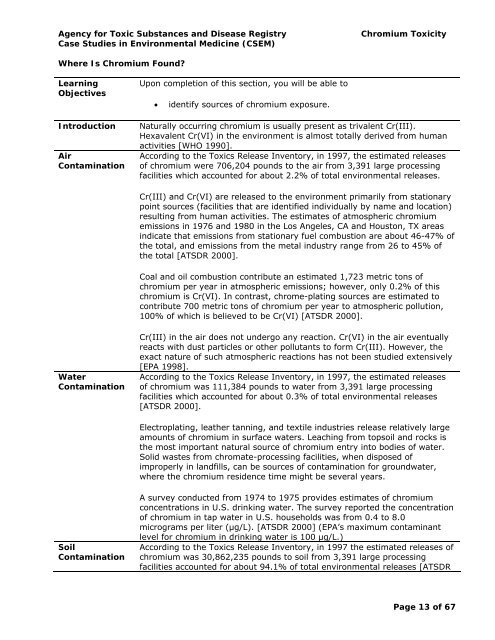(Cr) Toxicity | ATSDR - CSEM - Agency for Toxic Substances and ...
(Cr) Toxicity | ATSDR - CSEM - Agency for Toxic Substances and ...
(Cr) Toxicity | ATSDR - CSEM - Agency for Toxic Substances and ...
You also want an ePaper? Increase the reach of your titles
YUMPU automatically turns print PDFs into web optimized ePapers that Google loves.
<strong>Agency</strong> <strong>for</strong> <strong>Toxic</strong> <strong>Substances</strong> <strong>and</strong> Disease Registry Chromium <strong><strong>Toxic</strong>ity</strong><br />
Case Studies in Environmental Medicine (<strong>CSEM</strong>)<br />
Where Is Chromium Found?<br />
Learning<br />
Objectives<br />
Upon completion of this section, you will be able to<br />
• identify sources of chromium exposure.<br />
Introduction Naturally occurring chromium is usually present as trivalent <strong>Cr</strong>(III).<br />
Hexavalent <strong>Cr</strong>(VI) in the environment is almost totally derived from human<br />
activities [WHO 1990].<br />
Air<br />
Contamination<br />
Water<br />
Contamination<br />
Soil<br />
Contamination<br />
According to the <strong>Toxic</strong>s Release Inventory, in 1997, the estimated releases<br />
of chromium were 706,204 pounds to the air from 3,391 large processing<br />
facilities which accounted <strong>for</strong> about 2.2% of total environmental releases.<br />
<strong>Cr</strong>(III) <strong>and</strong> <strong>Cr</strong>(VI) are released to the environment primarily from stationary<br />
point sources (facilities that are identified individually by name <strong>and</strong> location)<br />
resulting from human activities. The estimates of atmospheric chromium<br />
emissions in 1976 <strong>and</strong> 1980 in the Los Angeles, CA <strong>and</strong> Houston, TX areas<br />
indicate that emissions from stationary fuel combustion are about 46-47% of<br />
the total, <strong>and</strong> emissions from the metal industry range from 26 to 45% of<br />
the total [<strong>ATSDR</strong> 2000].<br />
Coal <strong>and</strong> oil combustion contribute an estimated 1,723 metric tons of<br />
chromium per year in atmospheric emissions; however, only 0.2% of this<br />
chromium is <strong>Cr</strong>(VI). In contrast, chrome-plating sources are estimated to<br />
contribute 700 metric tons of chromium per year to atmospheric pollution,<br />
100% of which is believed to be <strong>Cr</strong>(VI) [<strong>ATSDR</strong> 2000].<br />
<strong>Cr</strong>(III) in the air does not undergo any reaction. <strong>Cr</strong>(VI) in the air eventually<br />
reacts with dust particles or other pollutants to <strong>for</strong>m <strong>Cr</strong>(III). However, the<br />
exact nature of such atmospheric reactions has not been studied extensively<br />
[EPA 1998].<br />
According to the <strong>Toxic</strong>s Release Inventory, in 1997, the estimated releases<br />
of chromium was 111,384 pounds to water from 3,391 large processing<br />
facilities which accounted <strong>for</strong> about 0.3% of total environmental releases<br />
[<strong>ATSDR</strong> 2000].<br />
Electroplating, leather tanning, <strong>and</strong> textile industries release relatively large<br />
amounts of chromium in surface waters. Leaching from topsoil <strong>and</strong> rocks is<br />
the most important natural source of chromium entry into bodies of water.<br />
Solid wastes from chromate-processing facilities, when disposed of<br />
improperly in l<strong>and</strong>fills, can be sources of contamination <strong>for</strong> groundwater,<br />
where the chromium residence time might be several years.<br />
A survey conducted from 1974 to 1975 provides estimates of chromium<br />
concentrations in U.S. drinking water. The survey reported the concentration<br />
of chromium in tap water in U.S. households was from 0.4 to 8.0<br />
micrograms per liter (μg/L). [<strong>ATSDR</strong> 2000] (EPA’s maximum contaminant<br />
level <strong>for</strong> chromium in drinking water is 100 μg/L.)<br />
According to the <strong>Toxic</strong>s Release Inventory, in 1997 the estimated releases of<br />
chromium was 30,862,235 pounds to soil from 3,391 large processing<br />
facilities accounted <strong>for</strong> about 94.1% of total environmental releases [<strong>ATSDR</strong><br />
Page 13 of 67

















